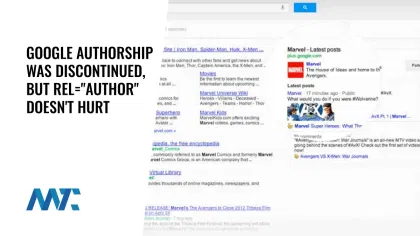
Google Authorship was a feature that allowed Google to identify the author of a piece of content and display their name and profile photo alongside the content in search engine result pages (SERPs). It also was included as a direct ranking factor for content.
Authorship was designated by adding rel=”author” markup to the content, which linked it to the author’s Google+ profile. Google+ was launched in 2011 as a competitor to Facebook. However, it never gained the same level of popularity.
Google Authorship was discontinued in August 2014 for a few reasons:
- Low adoption: Only a small percentage of websites and authors implemented Google Authorship.
- Limited impact: Google found that Google Authorship had little effect on click-through rates.
- Focus on other features: Google was focusing on other features, such as featured snippets and rich snippets, which were seen as more important for improving the quality of search results.
In 2018, Google announced that it would be shutting down the consumer version of Google+. The business version of Google+, called Currents, was retired on February 10, 2022. Although Google Authorship is no longer supported, the rel=”author” markup can still be used to link content to an author’s website or social media profile.
rel=”author”
The rel="author" attribute is an HTML markup attribute that can be still be used to establish authorship and indicate the original author of a piece of content on the web. It is primarily used in the context of blog posts, articles, or other written content.
The rel="author" attribute is often associated with the a (anchor) element, typically used for linking. It is used to link the author’s name to their author profile or bio page on the same website or a different website.
By using rel="author", website owners can provide a clear indication to search engines about the primary author of a piece of content. This helps search engines understand and attribute the content to the correct author. Search engines may use this information in various ways, such as displaying author information in search results or factoring in author reputation and authority when ranking search results.
When search engines encounter the rel="author" attribute, they may follow the link provided and gather additional information about the author from the linked author profile or bio page. This information can be used to establish the credibility and expertise of the author.
<article>
<h1>Article Title</h1>
<p>Article content goes here...</p>
<footer>
<p>Written by: <a href="https://martech.zone/author/douglaskarr/" rel="author">Douglas Karr</a></p>
</footer>
</article>It’s worth noting that the rel="author" attribute has become less prevalent in recent years. However, providing clear authorship information can still have indirect benefits, such as enhancing the visibility and credibility of the content.